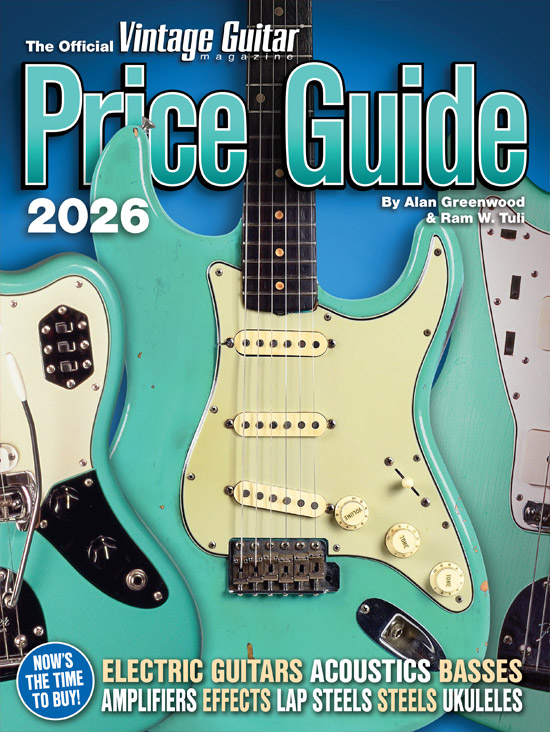
Surveying a small sample of Rick Vito’s resumé, versatility is a given. From the early ’70s, he has been tapped by John Mayall, Bonnie Raitt, Jackson Browne, Dolly Parton, Maria Muldaur, Roy Orbison, and Boz Scaggs, and his ’80s work with Bob Seger is familiar to television viewers everywhere.
He did four years touring and recording with Fleetwood Mac, and in 2020 was the obvious choice to sing and play guitar at Mick Fleetwood & Friends’ tribute to Mac founder Peter Green.
Vito’s 10th solo album, Cadillac Man, perfectly balances taste and swagger, while demonstrating another impressive tool – his hip songwriting.
When did you take up guitar?
I was seven or eight. My mom had an Oahu acoustic Hawaiian guitar that she’d played as a girl. My first good guitar was a Gibson ES-125 and a little birchwood Alamo amp. From there, I went to a Gretsch Twist model Corvette, and then I got a ’63 Tele.
Who were your early influences?
I had Duane Eddy 45s and the Ventures. I tried to learn Chuck Berry, which was hard until I heard Keith Richards playing it. A pet peeve of mine is people playing crappy versions of Chuck Berry – even Jimi Hendrix at Berkeley (Johnny B. Goode). They never get the rhythm right – it’s always too straight-ahead, not swinging. The early Stones got it better than a lot of bands.
From there, every blues guy – from Magic Sam to Otis Rush, all the Kings.
What prompted your move from Philly to Los Angeles?
In late 1970, I met Delaney & Bonnie & Friends, and they said if I wanted to get into the music business, I needed to move to L.A. So I did the next year, and they hired me to go on the road for a summer. The first record I played on was Something, Anything by Todd Rundgren, and I worked with Bobby Whitlock. I networked and made a living.
In ’75, Steve Cropper produced a John Prine album I was on, and in ’76 I did Roger McGuinn’s Thunderbyrd. Richard Bowden, who played with Linda Ronstadt, created a palm pedal; I was trying to learn how to play country, and it sort of sounded like Clarence White’s StringBender, so it fit with McGuinn. It was definitely outside my blues-rock thing, but it was fun.
Peter Green is an obvious influence. How did you come to join Fleetwood Mac?
I met Mick Fleetwood at a Billy Burnette session, and we talked about Peter, who made a big impression on me. He played so tasty, I thought, “There’s something to strive for.” I didn’t want to be a shredder, I didn’t want to play too loud; I wanted to play like that. He epitomized a great guitar personality.
Mick sat in with my band, and weeks later, Lindsey Buckingham left the band. Mick asked if I wanted to learn some songs and play with him. Afterward, he said, “If you want the gig, you’re in.” So I did that from ’87 to ’91. In 2005, he wanted to put together a Mick Fleetwood Blues Band to do stuff from the Peter Green era. He’s a fun guy to play with and one of the best drummers.
Thanks to the commercial for Chevy trucks, everyone is familiar with your slide solo on “Like A Rock” by Bob Seger.
Tracking that song, I told Bob I wanted to put slide on it and he said, “No, I don’t hear that. I don’t really like slide guitar.” I said, “Give me one pass.” So I had to do it without really knowing the song. I played my ’56 Les Paul TV through a 100-watt Dumble Overdrive Special head that Jackson Browne had given me, and a 2×12 bottom.
The first slide I heard was in “Little Red Rooster” with Brian Jones. Then, Jesse Ed Davis on Taj Mahal records. Around that time, I was getting into every blues record I could afford; Elmore James, Earl Hooker, and Robert Nighthawk were strong influences. I tried to absorb some of what Ry Cooder was doing, and I’ve always thought Mick Taylor was a great rock-and-roll slide player.
Which guitars are you playing on Cadillac Man?
I’ve had four signature models with Reverend Guitars. On the new album, I’m playing the Soul Agent. Versatility is the key, so I want a Fender-playing neck and pickups that can get a Fender and a Gibson sound. There’s a humbucker (bridge) and a P-90 (neck), and you can pull up on the Volume knob to get a single-coil kind of sound, though it’s still humbucking. Pull up on the Tone knob in the middle position, and it’s out-of-phase. They all have Bigsbys, which I try to use creatively.
Is it more difficult to release albums in this age of streaming?
I don’t even think of that. I do it for personal satisfaction, as an artistic statement. I don’t expect to make X amount of dollars; that’s not what it is anymore. It’s for the love of music. If anything happens with it, all the better.
This article originally appeared in VG’s June 2024 issue. All copyrights are by the author and Vintage Guitar magazine. Unauthorized replication or use is strictly prohibited.



